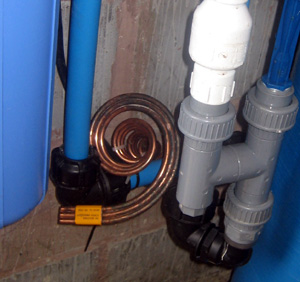Improving Soil Fertility
Over the years, our Vortex Energiser has been very successfully used for industrial and agricultural applications such as improving soil fertility.
Early on, horticultural trials in Northern Ireland carried out by the One World Garden Centre, demonstrated that plants watered with energised water (with a Vortex Energiser on the irrigation system) required only half the feed, had a healthier stronger root structure and produced a significant increase in yield compared to non-
Since then we have heard of bumper crops of shitaki mushrooms in the USA and butternut pumpkins in Australia see the testimonial below.
A few years ago we received great feed-
The most marked results were achieved in connection with compost. Several compost-
The Vortex Energiser stimulates oxygen-
This means that bio-
These results have prompted us to develop an industrial version of the Vortex Energiser. The Industrial Vortex EnergiserTM is approximately the same size as the standard Vortex Energiser, but is made from much heavier gauge copper tubing. The Industrial Vortex Energiser is therefore much heavier and more robust.
As a guideline, please use 1 standard Vortex Energiser on any pipe up to a diameter of 2 inches, 2 Vortex Energisers for a 3 inch pipe and 3 Vortex Energisers for a 4 inch pipe. Several Vortex Energisers can bee attached to a pipe in a cluster around the pipe or spaced out along the length of the pipe –
Initial tests have shown that in applications where 3 standard Vortex Energisers are required, 1 Industrial Vortex Energiser will suffice. In addition to this, due to its heavy-
Please contact us if you are interested in the Industrial Vortex Energiser.

My brother in-law is a farmer near Swan Hill in Victoria (Australia) and makes use of irrigation for farming. Only problem is that the water by the time it gets to him has been polluted by chemicals and salt and been run down numerous channels to the point that it is very dead water.
I passed on a Vortex Energiser (VE) to him which was special in that I put a silver plated Personal Harmoniser (PH) in the throat of the VE. This boosts the power of the VE to stronger than a silver plated version. We gave it to him and told him to try it on his crops when he irrigated.
At the time he had a 3 acre crop of butternut pumpkins and the plants were about to grow their third crop. He told me that he wasn’t expecting much from the third crop as the plants and ground were exhausted from the first two crops as he only fertilizes once when he first plants and the third batch were always much smaller in size and number. He also noted at the time that it had been a while since rain had fallen and the plants were starting to die off. This would be a good test of the VE as the only thing we were adding was energised water.
We looked at his irrigation system and selected a place for the VE (which was essentially submerged in the water) just after the take-off from the channel, pointing down the 4″ pipe that took the water to the field. We knew from experiments in the swimming pool with Nik that this configuration when submerged in water is very powerful and takes on a different dynamic.
It is now 6 weeks later and we went to see him this week-end. The success has been amazing. He normally gets around 1,000 boxes of pumpkins from this field from a good first crop. On this energised third crop he will get around 1,700 boxes, which is equivalent to somewhere around 200% increase. He only irrigated twice with the VE but reports that he noticed the difference the next morning. The plants had grown around 12″ overnight and the ends were standing upright. Exactly like he sees after a night of very heavy rain. The plants went green and started to grow. He now has a crop he just didn’t expect to have.
He has lent the VE to other farmers in the district to try out. He has had other farmers out to show them his crop and is absolutely convinced about the impact on the productivity. I think the reason it is so obvious is that the quality of the water is so bad.
We are going to set him up as a reseller for the time being, and we are not sure how fast this will take-off. We are going into winter here and the spring is around 4 months away, which is when the growing season starts.
However he believes that there will be results on winter crops and there are several farmers who don’t need any further convincing and want to purchase now.
Carl Agar, NEILOS
